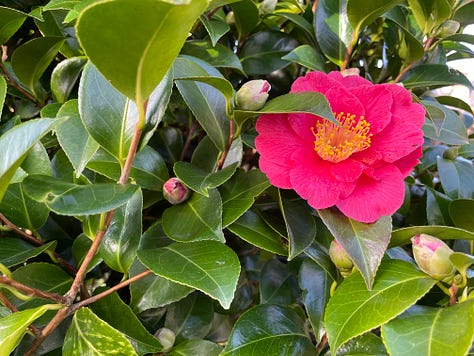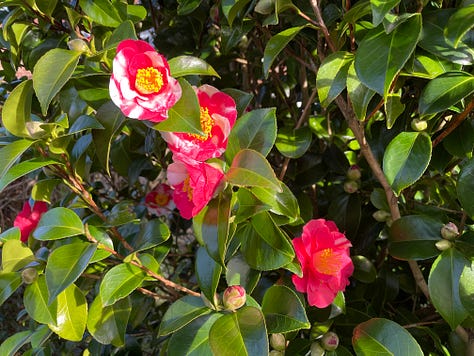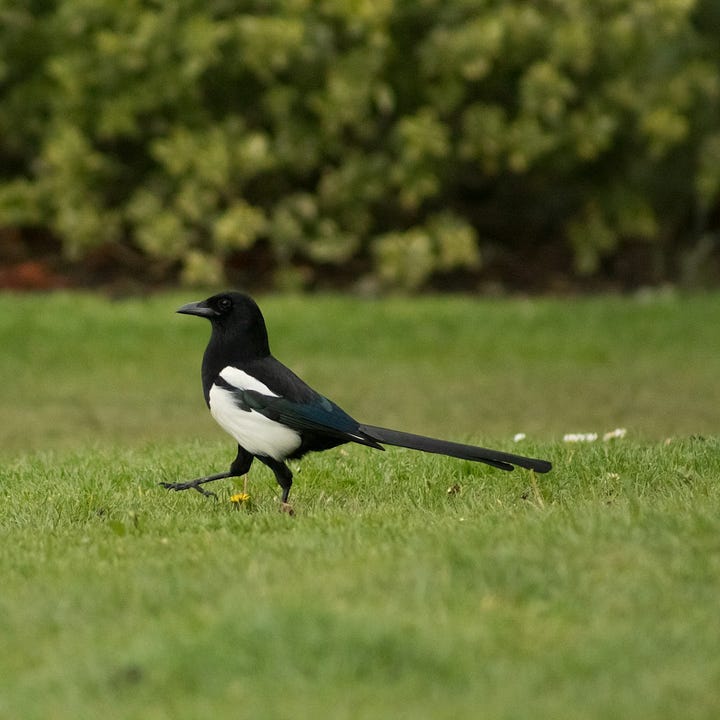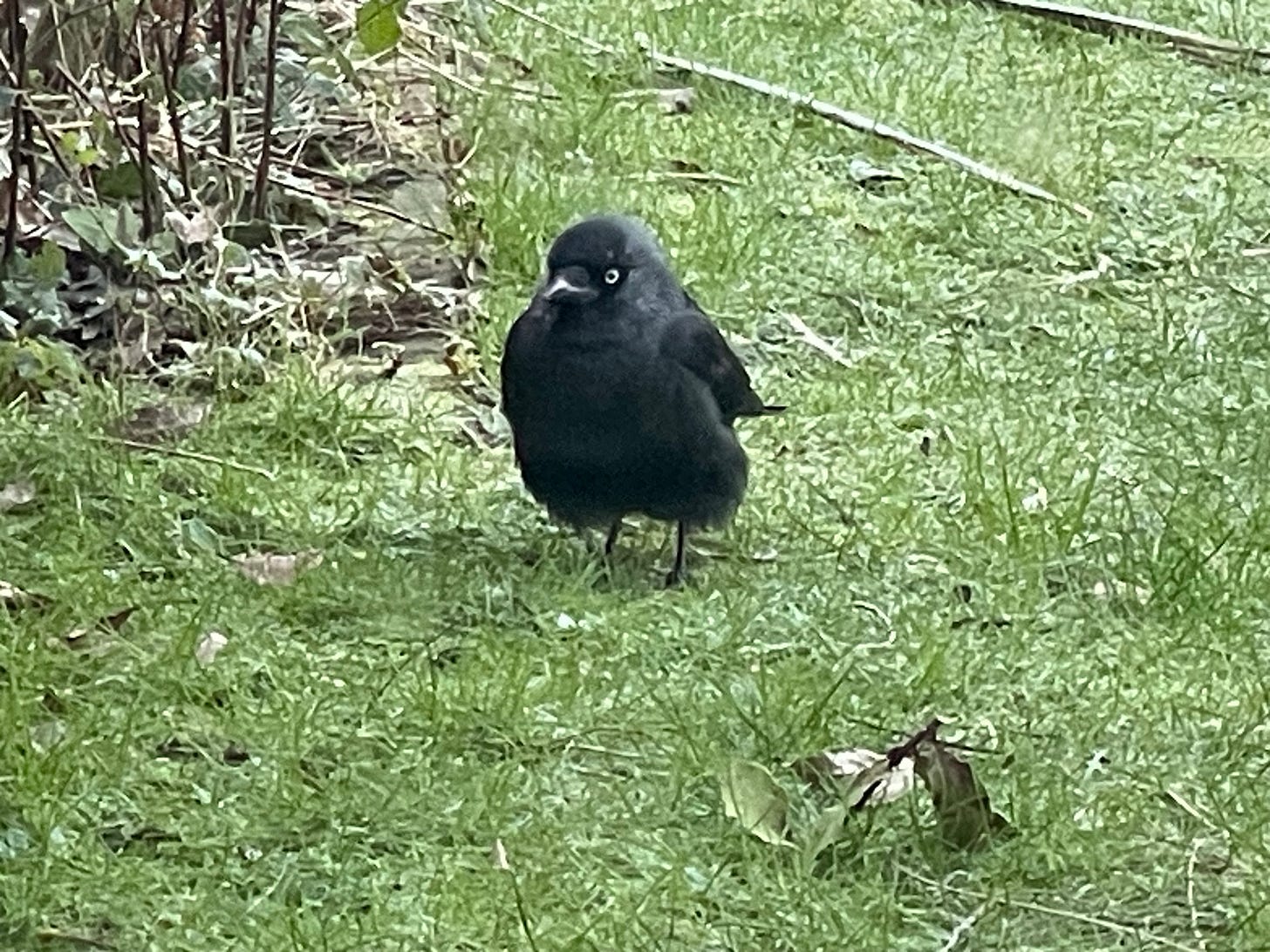Dear Reader,
It’s nice when our garden surprises me. Our beautiful red camellia gave us its first flower of the season soon after the start of January, and weeks on, there’s a whole flush of blooms and buds with the promise of more to come.



Instead of being only red, some of the flowers have petals with patches of white, their wintry candy cane and Christmas tree colour scheme a little late to the party now that it’s February. Red roses signal passion, while white ones are a sign of peace, so where does my red and white camellia stand, I wonder? Well, I don’t need to attach a meaning – both are beautiful.
And there’s more beauty, too. Our not-quite-spring garden is already alive with birds: we offer peanuts and sunflower hearts year round from two large feeders in our back garden, and supply plenty of water for drinking and bathing.
For years we’d had a succession of blackbirds1 which we’d tempt with mealworms outside the back door. They became so bold that they’d tap on the glass to get the attention of whichever one of us was in the kitchen, and once a female blackbird caught me – and indeed herself – by surprise when she flew into the kitchen and perched on the upper tray of the dishwasher as I was trying to unload it.

We haven’t had a tame blackbird around for a while now, and without them ruling the roost some larger birds have started to come regularly to claim a free meal.
We don’t much like the brash, swaggering magpies2 with their aggressive approaches to the smaller birds, but regarded one large black and white bird which had landed in the garden one morning with particular interest.
I misheard Jim when he first spotted it. ‘That’s a funny looking motorbike’, he said.
‘What?’ I asked. Jim couldn’t even see the road from where he was standing. Wherever had he spotted a motorbike?
‘That magpie’, he said, this time more clearly.


In fact it wasn’t a magpie at all, but a jackdaw with, unusually, a number of white flight feathers on each of his wings. ‘Motorbike’, as we inevitably dubbed our new two-tone friend, was symmetrical in his colouring, and his white wing flashes would attract our attention every time he flew in and out of the garden.
Jackdaw – Corvus monedula
🐦⬛
The jackdaw is a small black crow with a distinctive silvery sheen to the back of its head. Its pale eyes stand out from its plumage. The jackdaw's call – a familiar hard 'tchack' – gives it its name. It will often nest in chimneys, buildings, rock crevices and tree holes.
🐦⬛
Taken from the RSPB website.

🐦⬛
He hung out with a gang of noisy compatriots, and together they would fly up and down the lane, showing each other – and the much smaller birds – who was boss, and raiding our neighbours’ bird feeders too on what we were certain was a timetabled circuit.
It didn’t look as if Motorbike was the leader of the gang, but he certainly held his own with the rest of the rabble. We missed him when he stopped coming.
Last autumn we noticed a new garden visitor in the form of a fluffed-up jackdaw looking rather sorry for himself. He might have been a youngster, although certainly mature enough to be out on his own. And that, in fact, was the problem.
Reader, he was alone.
The moping creature would regard us from a spot halfway down the garden, and it seemed that whenever he noticed one of us paying him any attention from our vantage point the other side of the glazed door to the kitchen he would march towards a leaf on the lawn and busy himself turning it over and over.
I had never seen such obvious efforts towards nonchalance; such very deliberate moves to not be noticed.
Jim found me one morning standing at the kitchen door laughing as I waited for the kettle to boil.
‘I’ve never seen anyone take so much trouble to be inconspicuous!’ I told him.
‘Oh, Jacko?’ he replied, with a fond look on his face. He shook his head. ‘Silly bird.’
Like Motorbike before him, Jacko looked different to the jackdaws in the bird books, but unlike Motorbike Jacko’s arrangement of white feathers was anything but symmetrical. With his wings folded he showed a single white feather on his left and two on his right.
Lonely Jacko didn’t look like the picture of a jackdaw in the bird book, and the other jackdaws knew it. Almost every time we’d look out of the kitchen door he would be standing just a few feet away on the lawn looking sorry for himself.
‘He must be hungry’, I thought on one of his early visits, and popped a small handful of mealworms onto the brick paving between the bird and the door.
He held my gaze but didn’t move. Remembering his script – his feigned nonchalance – he strode up to the nearest leaf on the grass and began turning it over.
I had work to do, and realising how much time I was wasting I left Jacko – our feathered Sisyphus whose boulder was vegetable, not mineral – to his endless task.
When I next passed the kitchen door on my own journey to top up with tea, there was Jacko on the bricks, the untidy puddle of mealworms very much smaller. Catching sight of me he took off, then landed beside the nearest leaf on the lawn.
‘What?’ he seemed to be asking with his behaviour. ‘I’m not doing anything.’
Jacko began to appear most days, and although other jackdaws would come into the garden on occasion they neither wanted to hang out with him nor take him with them on their circuits around all the gardens in the lane. And worse: they’d pick on him, bully him, attack him and send him away.
Yet in time the other jackdaws made the connection between the presence of Jacko and the ready supply of mealworms. Ha! Our lopsided and preoccupied bird was now benefiting from rather more accommodating company from his cousins who didn’t have white feathers.
In the first world war a single white feather became a propaganda symbol to represent cowardice, and one would be given by women to young, fit men out of uniform to shame them publicly into enlisting. This sign of cowardice given under what became known as ‘The Order of the White Feather’ was later revived in World War Two.
Jacko had been ignored, alone, without friends, because of his white feathers. Were those making him out to be a coward?
Well, no. Because Reader, Jacko has found both courage and compatriots. He’s got us, first of all. If he’s by the back door when it’s time for me to walk down the garden to empty the kitchen caddy into the compost heap he’ll form the advance party, flying low above the lawn flashing me his white feathers, and he’ll land on the wooden table to watch me tip out the vegetable peelings. I’ll chat to him while he follows my every move with his pale grey eyes.
And by the time I’ve made it back up the garden to the kitchen door he’ll be right behind me.
Jacko’s finding his way in jackdaw company too. He invites the neighbourhood crew down to share his spoils, and the brick paving outside the kitchen door is very much his domain. The other jackdaws will make themselves scarce if they see anyone in the kitchen, but Jacko doesn’t bat an eyelid.
You see, his white feathers aren’t a sign of cowardice but of confidence. And I like to think that one day, when the black-feathered members of the jackdaw community take off from our garden to mount their next mission raiding the bird feeders of every garden along the lane, they’ll be taking Jacko along.
And just as the red and candy-striped blooms on the camellia have equitable hierarchy on its branches, it is clear that around here jackdaws with white feathers share equal status with those glossy black specimens featured on the pages of the bird book.
Love,
Rebecca
📚 Reading 📚
📚 Have you ever thought of telling your fortune with cheese? 🧀 Take a trip on
to find out how!📚 I write everything down, and this post by
on the subject of notebooking had grabbed my attention immediately:📚 In a similar vein I was thrilled to see this re-post by
about the many ways in which to use a diary. Wonderful!📚 Regular readers of ‘Dear Reader, I’m Lost' will be no strangers to my ongoing light-hearted letter-writing project with fellow Brit
of Eclecticism: Reflections on literature and life. It’s my turn to reply to him on Wednesday! You can find the archive of our chortlesome correspondence here.In case you haven’t met him yet, here’s some Terry to whet your appetite:
If you’ve enjoyed this post, please let me know by clicking the heart. Thank you!
Thank you for reading! If you enjoy ‘Dear Reader, I’m lost’, please share and subscribe for free.
Blackbird – Turdus marula
Male blackbirds are black with a bright orange-yellow beak and yellow eye-ring. Females are brown often with spots and streaks on their breasts and brown beak. The blackbird is one of the most common UK birds and one of the most striking. Its mellow song is also a favourite.
Taken from the RSPB website.
Magpie – Pica pica
With its noisy chattering, black-and-white plumage and long tail, there's nothing else quite like the magpie in the UK. When seen close-up, its black plumage reveals a purplish-blue iridescent sheen to the wing feathers and a green gloss to the tail. Magpies seem to be jacks of all trades – scavengers, predators and pest-destroyers. Non-breeding birds will gather together in flocks.
Taken from the RSPB website.











Poe and Hitchcock damaged the reputation of our feathered companions. You have flown in to restore it... Peace, Maurice
I loved this post. The mixed media painting is brilliant! We have jackdaws in our garden but they as discouraged because they take the moss off the roof, which would be ok if it wasn’t for the fact they take the very old crumbling tiles with it. They are all shapes and sizes too xx